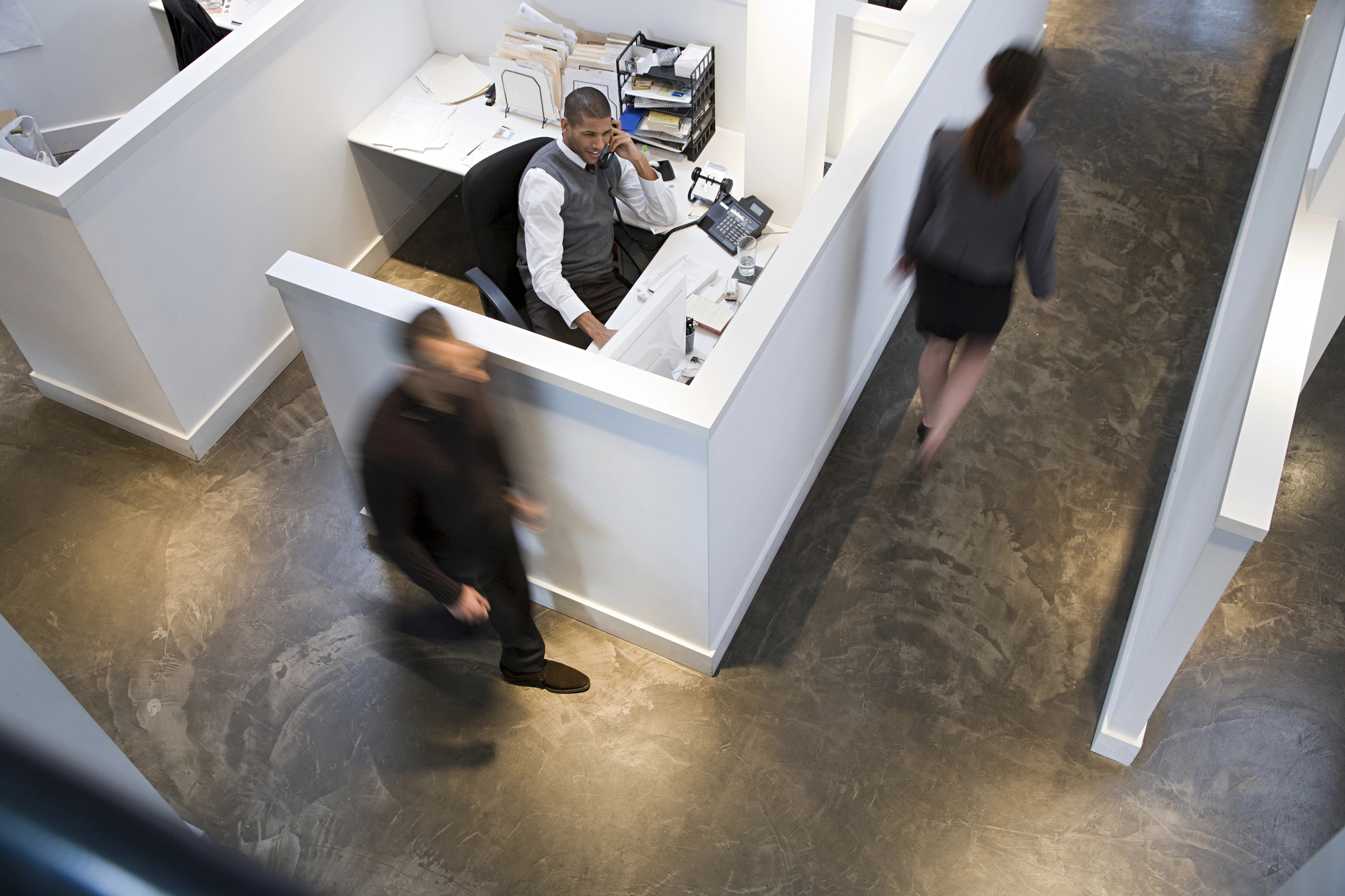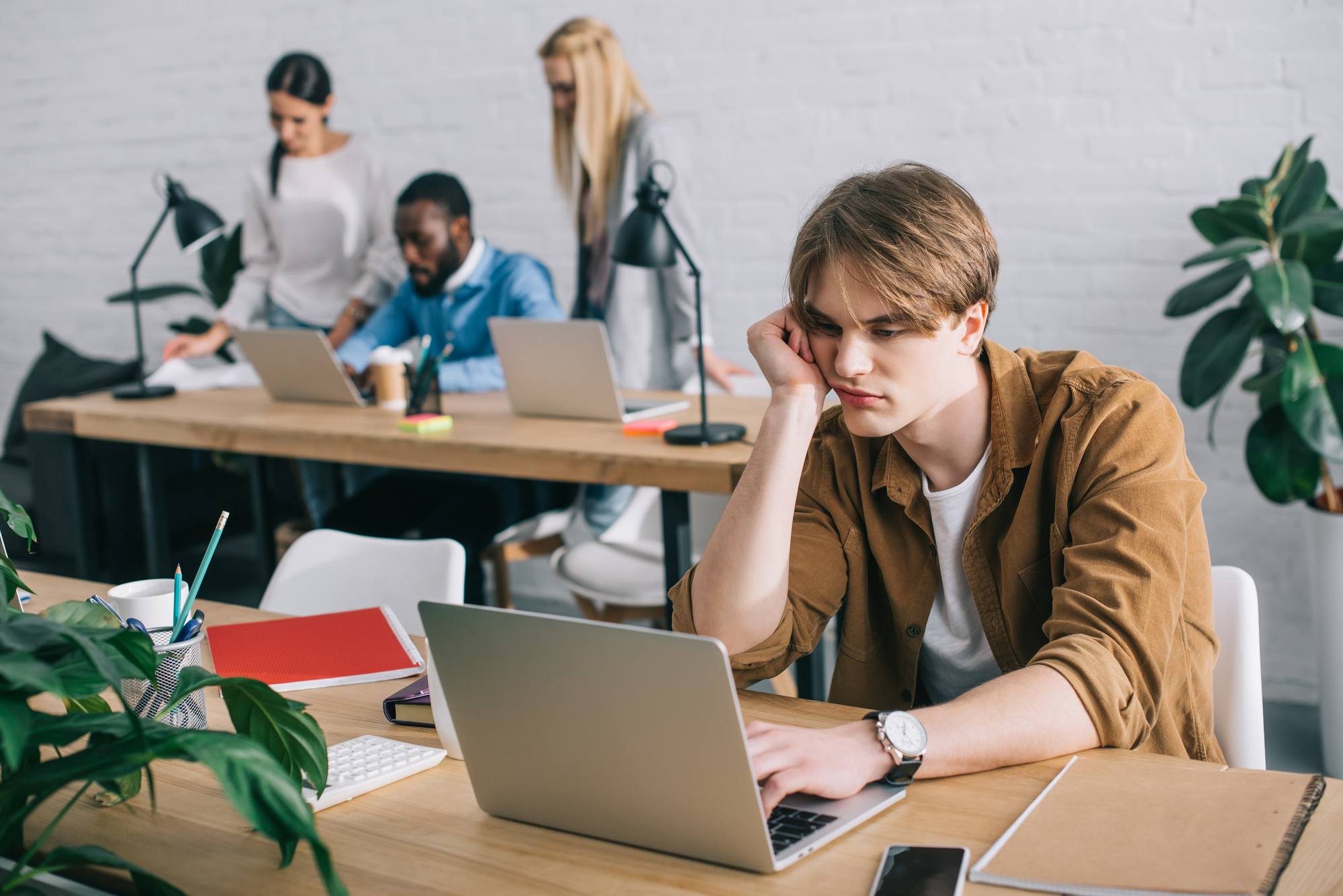This is why creatives hate traditional working environments.

If you’re a creative person, you’ll already know this better than anyone—traditional offices just aren’t built with you in mind!
Of course, there’s no one-size-fits-all approach to any type of person or job, but it’s a well-known fact that most typical workspaces are built for productivity, rather than creativity.
In this article, I highlight the top 10 reasons you might be struggling in your work environment, from the lack of flexibility (and frisbees!) to the underwhelming silence and structure…
1. They like the freedom of moving around.

The idea of being chained to your desk isn’t appealing to most people—but it makes creative people’s skin crawl more than most.
Having a set area to work from can be incredibly boring, especially given that creatives need more mental stimulation than most. They need to feel inspired or excited by their environment to truly thrive.
Being at a desk with the same view day in and day out can be challenging, and so can the lack of movement involved. Creative people often need to experience multiple changes or fresh settings during the day, and movement is key to that.
A sedentary body = a sedentary mind!
2. Background music gives them life.

Most corporate workplaces are on the quiet side because the majority of people work best in those types of environments. They want distractions to be kept to a minimum and prefer being able to get their head down and focus.
Creative people, on the other hand, need a bit of background noise in order to help them focus. It keeps their creative juices flowing, helps them stay engaged in their work, and spices things up a bit.
The idea of a silent, dull workspace is so uninspiring to most creative people, and it can actually make working a lot harder—and less enjoyable!
When they have the freedom to work from home, you’ll find that most people in creative jobs have at least one form of background noise, whether it’s music, a movie, or other people’s conversations in a cafe.
3. Regular breaks feed their creativity.

While all workers are allowed a lunch break and a few bathroom breaks during the day, a lot of creative people find that they need more regular breaks to truly thrive and enjoy their jobs.
This links back to our earlier point on experiencing a change in setting. By having regular breaks, creative people can gain inspiration and benefit from a bit of a reset.
Taking breaks allows the mind to reset, and it enables creativity to bloom in its own time. Rather than sitting and trying to force it, creative people usually need some extra time to get things moving again after a long morning.
They might find that a 5-minute wander around the building, or a brisk walk outside, really helps them replenish their creativity and work more productively.
4. Flexible hours drive output.

It might sound counterintuitive, but regular breaks often lead to more work being done overall!
Flexible working enables creative people to take the breaks they need, as mentioned above, get a change of scenery, and re-energize themselves throughout the day.
Admin-type jobs often don’t require a huge amount of creative energy, so it makes sense that people in those roles can sit down and do a day’s work relatively easily.
Creative roles, however, can take up a huge amount of creative energy (makes sense, right?), which needs topping up throughout the day.
Things like yoga, walking, cooking, or spending time with friends can boost that creative energy—which is why flexible working hours benefit creative people so much!
Having the flexibility to start work later, take a long lunch, or jump in and out of the office can make a huge difference to people in creative roles.
Unfortunately, this level of flexibility is rarely found in typical work environments…
5. Structure is suffocating.

Creativity isn’t structured, and it doesn’t occur on demand.
The idea of an intense routine can be stifling to people who are more creative than most traditional job roles cater to.
They might feel as though there’s no room for them to think properly (or creatively), which can inhibit their progress and lead to a very unproductive day.
Of course, creative people can’t ask to be treated differently to the general rules of the workplace, but there does need to be more flexibility for them to truly thrive.
They should still be expected to attend mandatory meetings, but a lot of creative people need more spontaneity during their working days to stay creative and not feel bogged down or trapped by the mundaneness of office life.
6. Inspiration isn’t confined to the office.

Offices aren’t exactly known for being inspiring, and they often have neutral interiors and minimal windows.
Without space to roam around and things to look at, a lot of creative people find themselves feeling uninspired and unmotivated.
If there isn’t enough room for color and noise and play, people in creative roles will start to struggle quite quickly.
To truly thrive, most people working in creative roles need to get out and about. They must be mentally stimulated by changing landscapes, conversations, or people-watching.
That might mean that they prefer to work from cafes or coworking spaces, or that they can work from home and roam around different rooms as they wish!
7. Non-traditional activities get the creative juices flowing.

Most creatives need some level of movement in their lives, which extends to their workplace.
Rather than simply sitting at a desk all day, many creative people need physical activity to get their thoughts flowing. They might prefer standing or walking desks so they’re not sedentary for hours.
They also might enjoy throwing a frisbee around the studio or having a dance break halfway through the afternoon. A lot of creative people need an energy release to get an energy boost.
Moving the body gives us access to new sensations, from new smells and sounds to new experiences and feelings. Rather than sitting down at a desk all day, creative people need to be doing things that get them excited.
Understandably, not many traditional work environments encourage this type of behavior—but I think they should!
8. Mornings aren’t ideal.

Creativity isn’t something that most people simply wake up with, even if they’re in that type of role.
Instead, creativity is something that blooms throughout the day or bursts out after an 11 am coffee and chat with friends.
Being restricted by set working hours can dampen creative mindsets. In fact, a lot of creative people are more active during the night—they get a rush of energy later than most people and find their best ideas when others are asleep.
Given that creatives are highly engaged outside of typical office hours, it makes sense that the mornings then aren’t great for them. If they’ve been up until 3 am working on a project, they probably aren’t going to be at their best at 8 am in the office the next day.
A lot of this comes down to our circadian rhythms—mornings are typically centered around logical thinking, which is great for those in admin, finance, or operational roles.
Evenings are the ideal times for creative people to be working, as the more intuitive, imaginative parts of the brain naturally awaken later in the day.
While there is science behind this, it’s not exactly the easiest thing to explain to your boss when you’re late for work again…
9. There’s not enough collaboration.

Creativity isn’t something that just occurs (for most of us, at least)—it’s usually the result of a stimulating environment, flexibility, and, most importantly, connection.
Connection fuels creativity. Conversations lead to new trains of thought, new opinions, and new ideas. The more creative people can collaborate and communicate, the more productive they are.
Of course, most workplaces actively discourage too much chatter! While they may allow collaboration, it’s often in the form of meetings or email chains. This type of communication doesn’t exactly lend itself to creativity….
Instead, creative people typically thrive in environments where exciting conversations happen face to face, during walks outside with colleagues, or, of course, while throwing a frisbee around the office.
10. Offices aren’t designed for creativity.

Workspaces are designed for productivity, which is often seen as the exact opposite of creativity.
Offices are designed to ensure a ‘cookie cutter’ worker—people who arrive on time, do the work with minimal fuss, are predictable, and follow orders.
They’re similar to factories—after all, factories were the original workplaces…
More traditional offices are built to produce a steady flow of output, so everything is kept the same for everyone, regardless of their role or personality type.
All variables are controlled, from the lack of music and activity to the timed breaks and daily schedules.
As such, it’s no surprise that most creatives simply don’t thrive in traditional work environments…









